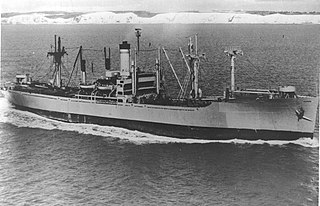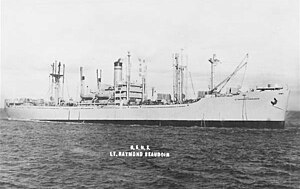
USNS Watertown (T-AGM-6) was a Watertown-class missile range instrumentation ship acquired by the United States Navy in 1960 and converted from her SS Niantic Victory Victory ship cargo configuration to a missile tracking ship, a role she retained for eleven years before being placed out of service in 1971.
SS Bessemer Victory was one of 534 Victory ships built during World War II. Named for Bessemer, Alabama, an industrial city honoring Sir Henry Bessemer, she was one of 218 such ships that were named after American cities.

USNS Perseus (T-AF-64) was a Denebola-class stores ship acquired by the U.S. Navy. Her task was to carry stores, refrigerated items, and equipment to ships in the fleet, and to remote stations and staging areas.

USS General C. C. Ballou (AP-157) was a General G. O. Squier-class transport ship for the U.S. Navy in World War II. She was named in honor of U.S. Army general Charles Clarendon Ballou. She was transferred to the U.S. Army as USAT General C. C. Ballou in 1946. On 1 March 1950, she was transferred to the Military Sea Transportation Service (MSTS) as USNS General C. C. Ballou (T-AP-157). She was later sold for commercial operation under several names before being scrapped some time after 1981.

USS General A. W. Brewster (AP-155) was a General G. O. Squier-class transport ship for the U.S. Navy in World War II. The ship was crewed by the U.S. Coast Guard throughout the war. She was named in honor of U.S. Army general Andre Walker Brewster. She was transferred to the U.S. Army as USAT General A. W. Brewster in 1946. On 1 March 1950 she was transferred to the Military Sea Transportation Service (MSTS) as USNS General A. W. Brewster (T-AP-155). She was later sold for commercial operation under the name SS Philadelphia, before being scrapped some time after November 1987.

USS General C. H. Muir (AP-142) was a General G. O. Squier-class transport ship for the U.S. Navy in World War II. The ship was crewed by the U.S. Coast Guard until decommissioning. She was named in honor of U.S. Army general Charles Henry Muir. She was transferred to the U.S. Army as USAT General C. H. Muir in 1946. On 1 March 1950 she was transferred to the Military Sea Transportation Service (MSTS) as USNS General C. H. Muir (T-AP-142). She was later sold for commercial operation under the names SS Chicago and SS San Juan, and was scrapped some time after 1985.

USS General H. F. Hodges (AP-144) was a General G. O. Squier-class transport ship for the U.S. Navy in World War II. The ship was crewed by the U.S. Coast Guard until decommissioning. She was named in honor of U.S. Army general Harry Foote Hodges. She was transferred to the U.S. Army as USAT General H. F. Hodges in 1946. On 1 March 1950 she was transferred to the Military Sea Transportation Service (MSTS) as USNS General H. F. Hodges (T-AP-144). She was later sold for commercial operation under the name SS James, before being scrapped in 1979.

USS General E. T. Collins (AP-147) was a General G. O. Squier-class transport ship for the U.S. Navy in World War II. She was named in honor of U.S. Army general Edgar Thomas Collins. She was transferred to the U.S. Army as USAT General E. T. Collins in 1946. On 1 March 1950 she was transferred to the Military Sea Transportation Service (MSTS) as USNS General E. T. Collins (T-AP-147). She was later sold for commercial operation under the name SS New Orleans, before being eventually scrapped.

USS General W. H. Gordon (AP-117) was a troop transport that served with the United States Navy in World War II. After the war, she was transferred to the US Army and served as USAT General W. H. Gordon. In the mid to late 1940s she sailed in trans-Pacific American President Lines passenger service with sister ship SS General Meigs. With the outbreak of the Korean War, she was reacquired by the Navy as a civilian-crewed Military Sea Transportation Service (MSTS) vessel, and redesignated USNS General W. H. Gordon (T-AP-117). She served again under the same designation in the Vietnam War.

USNS Fred C. Ainsworth (T-AP-181) was a troop transport that served with the United States Military Sea Transportation Service during the Korean War. Prior to her MSTS service, she served as US Army transport USAT Fred C. Ainsworth during World War II.

USNS Aiken Victory (T-AP-188) was a Victory ship-based troop transport that served with the United States Army Transport Service during both World War II and the Korean War. She was one of a class of 84 dedicated troop transports.

The Type C4-class ship were the largest cargo ships built by the United States Maritime Commission (MARCOM) during World War II. The design was originally developed for the American-Hawaiian Lines in 1941, but in late 1941 the plans were taken over by the MARCOM.

SS Dalton Victory was built as Victory ship used as a cargo ship for World War II under the Emergency Shipbuilding program. She was launched by the California Shipbuilding Company on 6 June 1944 and completed on 19 July 1944 as a Greenville Victory-class cargo ship. The ship’s United States Maritime Commission designation was VC2- S- AP3, hull number 21. She was acquired by the U.S. Navy in 1950 and renamed the USNS Dalton Victory (T-AK-256).
USNS Lt. James E. Robinson (T-AKV-3/T-AG-170/T-AK-274) was a Lt. James E. Robinson-class cargo ship, which was launched as a World War II commercial Victory cargo ship SS Czechoslovakia Victory under the Emergency Shipbuilding program. She had earlier been the U.S. Army's USAT LT. James E. Robinson before being acquired by the U.S. Navy.

USNS Lt. George W. G. Boyce (T-AK-251) was a Boulder Victory-class cargo ship built for the U.S. Maritime Commission during the final months of World War II.
USNS Lt. Robert Craig (T-AK-252) was a Boulder Victory-class cargo ship built for the U.S. Maritime Commission during the final months of World War II.
USNS Sgt. Truman Kimbro (T-AK-254) was a Boulder Victory-class cargo ship built for the U.S. Maritime Commission during the final months of World War II as the SS Hastings Victory.
USNS Rollins (T-AG-189) was one of 12 ships scheduled to be acquired by the United States Navy in February 1966 and converted into forward depot ships and placed into service with the Military Sea Transport Service. SS High Point Victory (MCV-851) was chosen for this conversion and assigned the name Rollins but the program was canceled and the ships were not acquired by the Navy.

USNS Marine Adder (T-AP–193) was a troop ship for the United States Navy in the 1950s. She was built in 1945 for the United States Maritime Commission as SS Marine Adder, a Type C4-S-A3 troop ship, by the Kaiser Company during World War II. In 1950, the ship was transferred to the Military Sea Transport Service of the U.S. Navy as a United States Naval Ship staffed by a civilian crew. After ending her naval service in 1957, she entered the National Defense Reserve Fleet, but was sold for commercial use in 1967. She was used in part to carry supplies to support the Vietnam War efforts. During the summer of ‘72 while in Da Nang harbor, South Vietnam a limpet mine was attached to the hull by a swimmer. The mine blew a hole in the hull. In order to save the ship the Skipper ran it aground in Da Nang harbor. The USS Navy standby salvage ship USS Grasp with its crew of divers installed a box patch over the hole and pumped the water from the bilges, before moving the ship to a pier. US Army tanks hung from ship booms to heel the ship so that a metal patch could be welded in place to return the ship to duty. SS Transcolorado, she was chartered by the Military Sealift Command as a civilian cargo ship designated T-AK-2005.

The SS Baylor Victory was a cargo Victory ship built during World War II under the Emergency Shipbuilding program. The Baylor Victory (MCV-772) was a type VC2-S-AP2 Victory ship built by California Shipbuilding Corporation in Los Angeles, California. The Maritime Administration cargo ship was the 772rd ship built. Her keel was laid on Jan. 13, 1945. She was launched on March 6, 1945 and completed on March 30, 1945. The 10,600-ton ship was constructed for the Maritime Commission. She operated her under the United States Merchant Marine act for the War Shipping Administration. She was named for Baylor University, a private Christian university in Waco, Texas. At her launching Baylor University was represented by 18 graduates and friends. University President Pat M. Neff gave a short speech at the launching and christening ceremony. Los Angeles District Judge Minor L. Moore, a Baylor graduate of 1900, also spoke. Baylor Victory was launched at 1:20 a.m. and was lit up by large floodlights.















